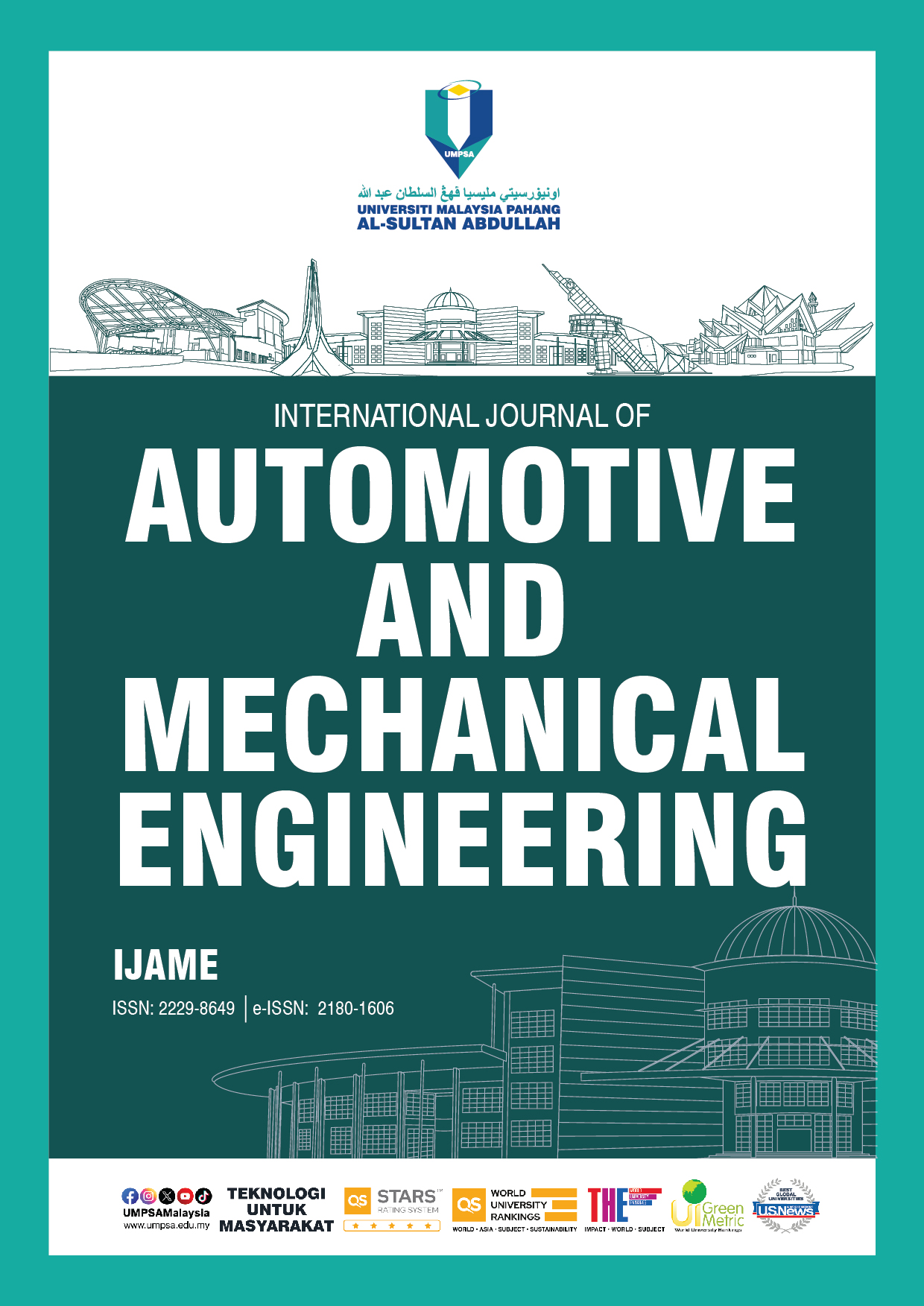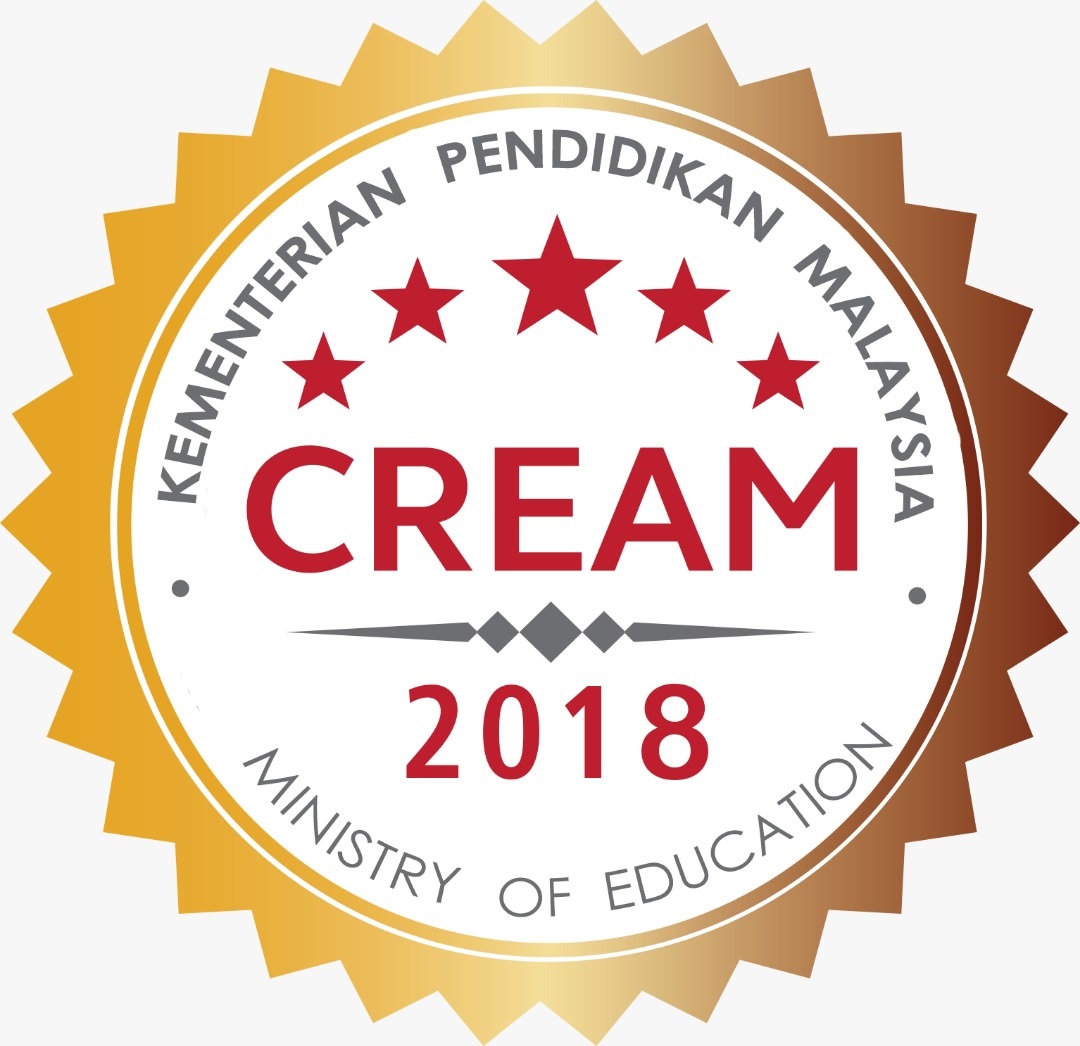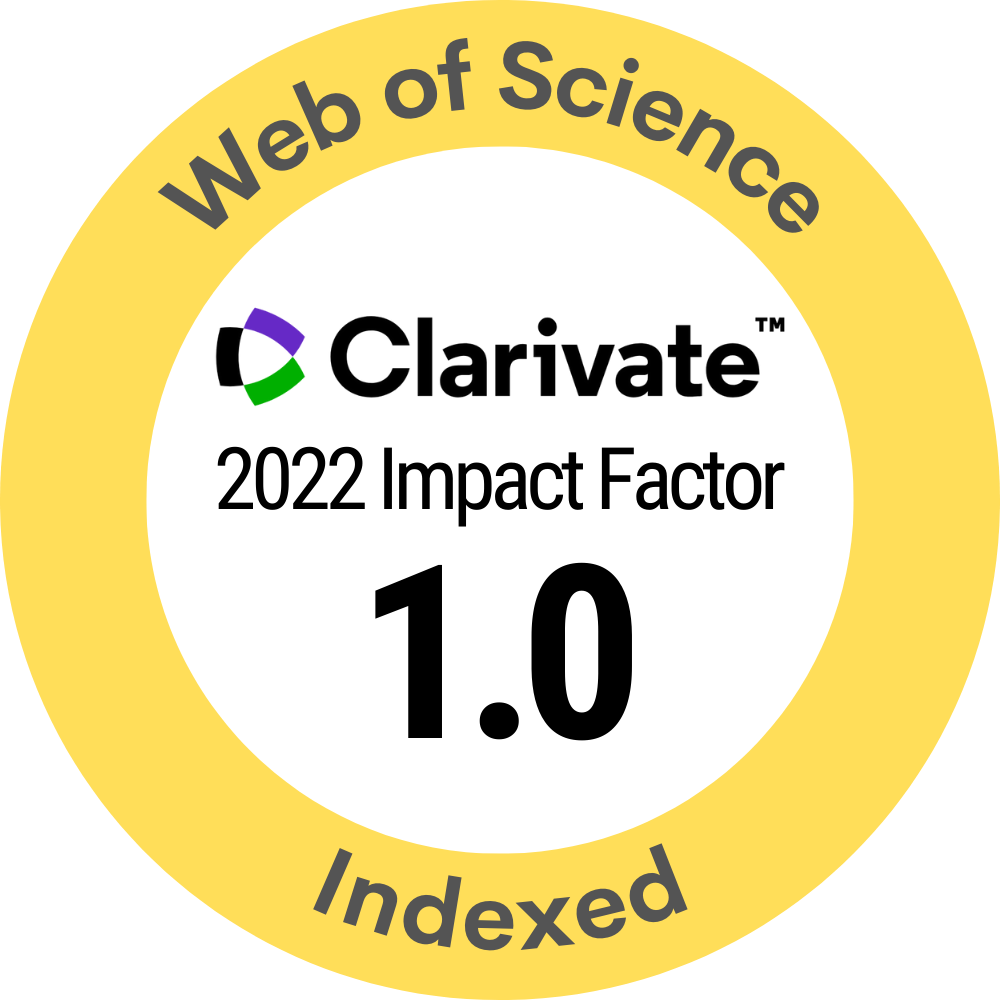Leucaena-Silicone Biocomposite: Experimentation, Quantification and Prediction of Mechanical Properties for Potential Applications in Medicine and Healthcar
DOI:
https://doi.org/10.15282/ijame.22.2.2025.7.0944Keywords:
Leucaena, Silicone, Biocomposite, Hyperelastic, Ogden, Artificial neural networkAbstract
Silicone rubber, in general, possesses super soft physical behavior, which is not suitable for structural applications. Therefore, this study aims to introduce an innovative biocomposite material combining Leucaena and Silicone, named LeuSiC, to establish its physical and mechanical properties for possible medical applications. Various Leucaena fiber compositions ranging from 0 wt% to 16 wt% were mixed with pure silicone rubber, where density, compression set, and uniaxial tensile behavior were experimentally investigated following ASTM standards. The Ogden hyperelastic constitutive was employed to quantify the tensile behavior of LeuSiC via material constants, µ and material exponent, α. Additionally, the tensile properties of LeuSiC were also predicted using Artificial Neural Network (ANN). The results revealed that the material constants, µ value, increased with higher Leucaena fiber composition, indicating stiffness increment. In contrast, increasing fiber composition reduced the tensile strength and flexibility of LeuSiC. In terms of prediction using ANN, the results proved the capability of the constructed neural network model, where the error was less than 0.4%. The quantified and predicted properties of µ and α range from 5.4 to 55.9 kPa and 2.16 to 3.0 respectively, suggest that LeuSiC has the potential to mimic and be made into synthetic connective tissues.
References
[1] N. A. Z. Abidin, J. Mahmud, N. A. S. Manssor, and N. N. C. Abd Rahim, “Physical and mechanical properties of Bamboo-Silicone Biocomposites (BaSiCs),” BioResources, vol. 17, no. 3, pp. 4432–4443, 2022.
[2] L. C. d. P. Araújo, M. E. Leyva, E. T. W. Neto, and A. A. A. de Queiroz, “Electrical properties of silver-silicone rubber nanocomposites for high-voltage outdoor insulators,” in IEEE Transactions on Dielectrics and Electrical Insulation, vol. 31, no. 3, pp. 1161-1168, 2024.
[3] M. Okoshi, “Fabrication of superhydrophobic silicone rubber operating in water,” Applied Physics Express, vol. 11, no. 10, pp. 10–12, 2018.
[4] M. Zare, E. R. Ghomi, P. D. Venkatraman, and S. Ramakrishna, “Silicone-based biomaterials for biomedical applications: Antimicrobial strategies and 3D printing technologies,” Journal of Applied Polymer Science, vol. 138, no. 38, p. e50969, 2021.
[5] S. H. K. Bahrain, N. N. C. A. Rahim, J. Mahmud, M. N. Mohammed, S. M. Sapuan, R. A. Ilyas, et al., “Hyperelastic properties of bamboo cellulosic fibre–reinforced silicone rubber biocomposites via compression test,” International Journal of Molecular Sciences, vol. 23, no. 11, 6338, 2022.
[6] P. Klongklaew, P. Khamjapo, P. Sae-Oui, P. Jittham, S. Loykulnant, and W. Intiya, “Characterization and application in natural rubber of leucaena leaf and its extracted products,” Polymers, vol. 15, no. 18, p. 3698, 2023.
[7] N. N. Azmi, Y. P. Gabrielle Marygrace, N. M. Mohd Noor, and M. H. A. Hasnul Hisham, “The effects of different eggshell-silicone biocomposite under uniaxial tensile loading,” Jurnal Mekanikal, vol. 46, pp. 30–37, 2023.
[8] M. I. Howlader, M. I. Mehedi, M. M. Alam, A. Z. M. Mofasser, N. I. Sayed, et al., “Mechanical and morphological analysis of natural fiver-reinforced epoxy and polyester hybrid composite,” Results in Engineering, vol. 26, p. 105010, 2025.
[9] A. C. Pereira, S. N. Monteiro, N. T. Simonassi, C. M. F. Vieira, A. M. Lima, U. O. Costa, et al., “Enhancement of impact toughness using graphene oxide in epoxy composite reinforced with ramie fabric,” Composite Structures, vol. 282, p. 115023, 2022.
[10] M. A. Mahmud, N. Abir, F. R. Anannya, A. Nabi Khan, A. N. M. M. Rahman, and N. Jamine, “Coir fiber as thermal insulator and its performance as reinforcing material in biocomposite production,” Heliyon, vol. 9, no. 5, p. e15597, 2023.
[11] A. Khan, S. M. Sapuan, V. U. Siddiqui, E. S. Zainudin, M. Y. M. Zuhri, and M. M. Harussani, “A review of recent developments in kenaf fiber/polylactic acid composites research,” International Journal of Biological Macromolecules, vol. 253, no. 5, p. 127119, 2023.
[12] M. Imraan, R. A. Ilyas, A. S. Norfarhana, S. P. Bangar, V. F. Knight, and M. N. F. Norrrahim, “Sugar palm (Arenga pinnata) fibers: new emerging natural fibre and its relevant properties, treatments and potential applications,” Journal of Materials Research and Technology, vol. 24, pp. 4551–4572, 2023.
[13] U.S. Bongarde and V.D. Shinde, “Review on natural fiber reinforcement polymer composites,” International Journal of Engineering Science and Innovative Technology, vol. 3, no. 2, pp. 431-436, 2014.
[14] M. S. M. Rasat, R. Wahab, M. Mohamed, M. I. Ahmad, M. H. M. Amini, et al., “Preliminary study on properties of small diameter wild leucaena preliminary study on properties of small diameter wild leucaena leucocephala species as potential biomass,” ARPN Journal of Engineering and Applied Sciences, vol. 11, no. 9, pp. 6128-6137, 2016.
[15] T. K. Lim, Edible Medicinal and Non-Medicinal Plants, Dordretch, Netherlands, Springer, 2012.
[16] W. M. N. Wan Abdul Rahman, N. Johari, S. Sarmin, N. Mohd Yunus, Y. Japaruni, J. Mahmud, et al., “Leucaena leucocephala: A Fast-growing Tree for the Malaysian Particleboard Industry,” BioResources, vol. 15, no. 4, pp. 7433–7442, 2020.
[17] K. Krishnasamy, J. Palanisamy, and M. Bhuvaneshwarana, “A review on natural fiber reinforced biocomposites properties and its applications,” in AIP Conference Proceedings, vol. 3192, no. 1, 020015, 2024.
[18] S. M. Surid, K. M. Maraz, S. Shahida, A. Ahmed, and R. A. Khan, “A review on the properties of natural fibers and manufacturing techniques of fiber reinforced biocomposites,” Modern Concepts in Material Science, vol. 4, no. 1, p. 000592, 2021.
[19] U. M. R. Paturi, S. Cheruku, and N. S. Reddy, “The role of artificial neural networks in prediction of mechanical and tribological properties of composites—A comprehensive review,” Archives of Computational Methods in Engineering, vol. 29, pp. 3109-3149, 2022.
[20] J. Niu and Y. Zhang, “Application of artificial neural networks in polymer composites: A review.” Asian Journal of Research in Computer Science, vol. 16, no. 4, pp. 67-79, 2023.
[21] ASTM International, ASTM D792-20: Standard Test Methods for Density and Specific Gravity (Relative Density) of Plastics by Displacement, West Conshohocken, PA, USA, ASTM International, 2020.
[22] ASTM International, ASTM D412-16: Standard Test Methods for Vulcanized Rubber and Thermoplastic Elastomers—Tension, West Conshohocken, PA, USA, ASTM International, 2021.
[23] ASTM International, ASTM D395-18: Standard Test Methods for Rubber Property—Compression Set, West Conshohocken, PA, USA, ASTM International, 2018.
[24] J. Mahmud, “The development of a novel technique in measuring human skin deformation in vivo to determine its mechanical properties,” Ph.D. dissertation, Cardiff University, United Kingdom, 2009.
[25] N. A. Z. Abidin, N. Othman, A. H. Zulkefli, and J. Mahmud, “Quantifying and predicting tensile properties of curcuma longa-silicone biocomposite,” Medziagotyra, vol. 28, no. 3, pp. 347–352, 2022.
[26] M. L. Sanyang, S. M. Sapuan, M. Jawaid, M. R. Ishak, and J. Sahari, “Development and characterization of sugar palm starch and poly (lactic acid) bilayer films,” Carbohydrate Polymers, vol. 146, pp. 36–45, 2016.
[27] S. H. K. Bahrain, N. R. N. Masdek, J. Mahmud, M. N. Mohammed, S. M. Sapuan, R. A. Ilyas, et al., “Morphological, physical, and mechanical properties of sugar-palm (Arenga pinnata (Wurmb) Merr.)-reinforced silicone rubber biocomposites,” Materials, vol. 15, no. 12, 4062, 2022.
[28] V. Chandran, T. Manvel Raj, and T. Lakshmanan, “Effect of recycled rubber particles and silica on tensile and tear properties of natural rubber composites,” Medziagotyra, vol. 22, no. 2, pp. 256–261, 2016.
[29] S. H. Kamarul Bahrain, J. Mahmud, and M. H. Ismail, “Arenga pinnata–silicone biocomposite properties via experimental and numerical analysis,” Medziagotyra, vol. 24, no. 3, pp. 277–282, 2018.
[30] I. D. Simonov-Emelyanov and K. I. Kharlamova, “Filler particle size and packaging and compositions of filled polymer composites with different types of structures and properties.” Theoretical Foundations of Chemical Engineering, vol. 54, pp. 1290–1296, 2020.
[31] M. R. Hasan and J. Coronas, “How can the filler-polymer interaction in mixed matrix membranes be enhanced?” ChemPlusChem, vol. 89, no. 12, p. e202400456, 2024.
[32] S. N. A. M Noor and J. Mahmud. “Modelling and computation of silicone rubber deformation adapting neo-hookean constitutive equation,” in Proceedings of 2015 Fifth International Conference on Communication Systems and Network Technologies (IEEE CSNT 2015), pp. 1323-1326, 2015.
[33] S. L. Evans and C. A. Holt, “Measuring the mechanical properties of human skin in vivo using digital image correlation and finite element modelling”. Journal of Strain Analysis for Engineering Design, vol. 44, no. 5, pp. 337–345, 2009
[34] O. A. Shergold, N. A. Fleck, and D. Radford, “The uniaxial stress versus strain response of pig skin and silicone rubber at low and high strain rates,” International Journal of Impact Engineering, vol. 32, no. 9, pp. 1384–1402, 2006.
[35] J. Mahmud, S. H. M. Yusop, and S. N. A. M. Noor, “Leather and synthetic leather: A mechanical viewpoint for sustainability,” in Engineering and Technical Development for a Sustainable Environment, D. Kamarun, R. M. Tajuddin, B. Abdullah, 1st Ed., New York, USA: Apple Academic Press, 2017.
[36] K. L. Grega, R. N. Segall, A. J. Vaidya, C. Fu, and B. B. Wheatley, “Anisotropic and viscoelastic tensile mechanical properties of aponeurosis: Experimentation, modeling, and tissue microstructure,” Journal of the Mechanical Behaviour of Biomedical Materials, vol. 110, p. 103889, 2020.
[37] G. L. Polyzois, P. A. Tarantili, M. J. Frangou, and A. G. Andreopoulos, “Physical properties of a silicone prosthe tic elastomer stored in simulated skin secretions,” The Journal of Prosthetic Dentistry, vol. 83, no. 5, pp. 572–577, 2000.
[38] B. Kim, S. B. Lee, J. Lee, S. Cho, H. Park, S. Yeom, et al., “A comparison among Neo-Hookean model, Mooney-Rivlin model, and Ogden model for Chloroprene rubber,” International Journal of Precision Engineering Manufacturing, vol. 13, no. 5, pp. 759–764, 2012.
[39] B. Jiang, “Do we need very stiff fillers?” Rubber Chemistry and Technology, vol. 90, no. 4, pp. 743–750, 2017.
[40] N. K Faheed, “Advantages of natural fiber composites for biomedical applications: a review of recent advances,” Emergent Materials, vol. 7, pp. 63–75, 2024.
[41] A. Jinlin, C. Xie, and F. Wei, “Research on time dependent constitutive model and structural performance degradation prediction of silicon foam,” Polymer Testing, vol. 129, p. 108297, 2023.
[42] M. N. A. Ab Patar, N. A. S. Manssor, M. R. Isa, N. A. I. Jusoh, M. J. Abd Latif, P. N. Sivasankaran, et al., “Quantifying and predicting the tensile properties of silicone reinforced with moringa oleifera bark fibers,” BioResources, vol. 19, no. 2, pp. 3461–3474, 2024.
[43] F. Mohammadi, B. Bina, H. Karimi, S. Rahimi, and Z. Yavari, “Modeling and sensitivity analysis of the Alkylphenols removal via moving bed biofilm reactor using artificial neural networks: Comparison of levenberg marquardt and particle swarm optimization training algorithms,” Biochemical Engineering Journal, vol. 161, p. 107685, 2020.
[44] E. E. Supeni, J. A. Epaarachchi, M. M. Islam, and K. T. Lau, “Development of artificial neural network model in predicting performance of the smart wind turbine blade,” Journal of Mechanical Engineering Science, vol. 6, pp. 734–745, 2014.
[45] Y. Zhang, J. R. G. Evans, and S. Yang, “Exploring correlations between properties using artificial neural networks,” Metallurgical and Materials Transactions A, vol. 51, pp. 58–75, 2020.
[46] H. Yildirim, “Prediction of weight change of glass fiber reinforced polymer matrix composites with SiC nanoparticles after artificial aging by artificial neural network-based model,” Journal of Materials Science, vol. 60, pp. 5064-5079, 2025.
[47] S. Palanisamy, N. Ayrilmis, K. Sureshkumar, C. Santulli, T. Khan, H. Junaedi, et al., “Machine learning approaches to natural fiber composites: A review of methodologies and applications,” BioResources, vol. 2, no. 1, pp. 2321-2345, 2025.
Downloads
Published
Issue
Section
License
Copyright (c) 2025 The Author(s)

This work is licensed under a Creative Commons Attribution-NonCommercial 4.0 International License.







